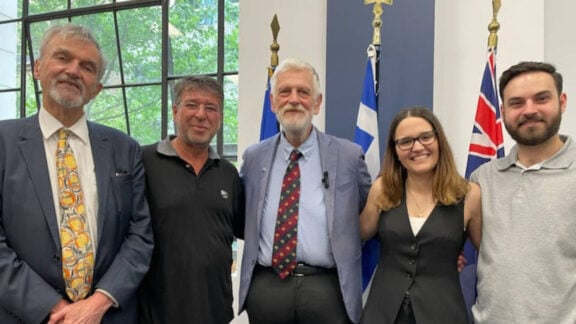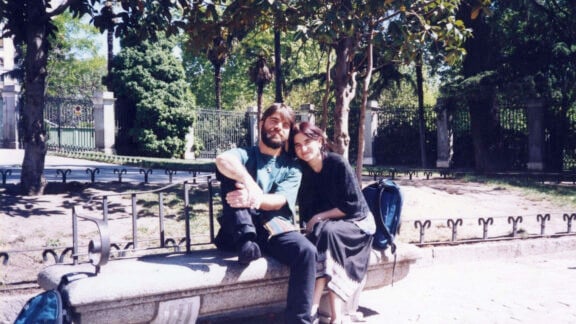It was my honour today to take part in the ceremony held at Melbourne’s beautiful State Library of Victoria for the donation by the Zapantis family of an important book. The book is entitled The Sacrifices of Greece in the Second World War and was published in Greece soon after the end of the war. It has been my pleasure to have assisted the family throughout the donation process. The acceptance of this volume into the State Library’s collection is the latest in a series of donations of archival collections that I have assisted in, such as the Greek campaign collections of both Alfred Huggins and Syd Grant.
The ceremony took place in one of the ornate book-lined rooms of the State Library. Along with myself, those in attendance included the Greek Consul General Mr Emmanuel Kakavelakis, Dr Kevin Molloy of the SLV, Ms Denise Zapantis and family, author Ms Juliana Charpantidou and many friends of the Zapantis family, including author Dr John Martino. Mr Pano Apostolou from SBS Radio was also present.
The book is a unique statistical and graphical account of the destruction caused by the Axis invasion and occupation of Greece. The book no doubt played a role Greece’s appeal for post-war reconstruction aid.

The work on the book commenced as the occupation began in May 1941. The information was collected by a team of architects from the Greek Ministry of Reconstruction, led by Mr Konstantinos Doxiadis, the famous Greek architect and urban planner. After the end of the war his service against the Axis invasion and occupation saw him awarded both the Greek War Cross and the Order of the British Empire, the latter citing his activities in the Greek resistance and support of the Allied Forces. Such recognition to a non-British national indicates the significance of his work for the Allies during the war.
The book states its purpose as being “to give to the international opinion a summary picture of the price paid by the Greek people in the defence of the great ideals of freedom and justice.” In this task it dramatically succeeds.
The book unfolds as a series of chapters, each addressing a particular phase of the war and occupation or key aspects of their impact. There are chapters on the following – situation in Greece prior to the war; the unfolding of the various phases of the war, invasion and occupation itself; on the economic consequences of the war and occupation including the terrible disruption to domestic production and destruction of national infrastructure; the destruction of towns and villages; and, finally a chapter is devoted to the awful impact of the war and occupation on the inhabitants of Greece.

The book explains the terrible affect of the war and occupation on civilians through a combination of factors. Enemy requisitions and the great reductions in Greece’s vital agriculture production (such as the almost total loss of dairy production due to the devastation of livestock) was compounded by the restrictions on movement implemented as a result of the zones of occupation which massively disrupted communications and trade, including of food stuffs. Added to this was the rapid rise of inflation, combined with depressed wages, reducing the public’s purchasing power, further undermining their ability to purchase the scarce food supplies available. The result was widespread malnutrition, famine, illness and death.

Combining the effects of the famine and civilian massacres (including the near destruction of Greece’s Jewish population), the book estimates that Greece lost over 1 million of its population as a result of the war, compared to its pre-war population and the likely growth that would have occurred without the war. One of the most moving maps is the diagrammatic representation of the Holocaust in Greece.
In terms of infrastructure, the book details the loss of roads, railways and bridges, of shipping and telegraphic communications equipment and networks. But most importantly it estimates that over 1,700 villages were deliberately destroyed by the Axis forces. 43% of all buildings in Greece were destroyed and at the end of the war 18% of the population was homeless. This destruction is shown dramatically in the detailed maps which identified the extent of the destruction of major cities, such as Piraeus, Ioannia, Volos, Chania and Thessaloniki. The destruction of the important Corinth Canal is dramatically revealed in a series of photographs.

The statistics and data provided in the book are supported by graphs and maps which clearly illustrate the impact of the war and occupation on Greece and its people. To these are added a series of photographic sections bringing to life these terrible impacts. Along with images of the destruction of towns, villages, roads, railways and bridges, we see the awful images of starvation, death and mass graves.
With the support of the Greek Government, the information contained in the book was first exhibited in Greece in November 1944 following the liberation, with subsequent exhibitions held in Paris, London and at the United Nations in San Francisco throughout 1945. The book was published in 1946, its text repeated in four languages – Greek, French, English and Russian. The publisher – the Aspioti-Elka company of Corfu – was one of the largest and most significant publishing houses in Greece. No doubt the book played a key role in the international discussions on post-war reconstruction which would result in the Marshall Plan delivering much needed aid to the former occupied nations of Europe, including Greece.

Dr Molloy commenced proceedings by thanking the Zapantis family in making this important donation, which will complement the State Library’s existing collection concerning Greece in the Second World War. In this he referred to the samples on display from the Alfred Huggins and Syd Grant collections of photographs taken by both these Australian servicemen during their service in the Greek campaign of 1941. In accepting the book into its collection, he noted that there are very few other copies in other libraries or public institutions across the world and certainly none in Australia.
Mr Kakavelakis referred to the life and work of Mr Dioxiadis, including his architectural training in pre-war Germany and his part in the Greek resistance. He also explained the significance and works of the Aspioti Elka publishing house, the publisher the book. He also reflected on how the donation was yet more evidence of the deep connection between Greece and Australia, through our common service in war and through migration. It is fitting that such a book – significant to Greece and Greeks – should find a home in Australia, in such an illustrious public institution.

In my own address, it was my pleasure to place the book in context, followed by a description of its key contents. Ms Charpantidou, the author of the recently published history of the Greek Community of Melbourne and Victoria, addressed the assembly in Greek, outlining the history of the publication and its authors.
The assembly then heard an address by Ms Denise Zapantis whose father Panagis from the village of Ratzakli on the southern coast of Kefalonia bought the book in Greece in the 1950’s. She described her father’s life, the impact of the war and his post-war experiences in Greece as well as how he came across the book. A humble and generous man, we owe it to him for his interest in obtaining the book and bringing it to Australia. A treasured possession, Denise expressed the view that in some small way the book may have provided her father with some comfort from the trauma of his wartime experiences. She concluded by stating that by detailing the terrible impact of she hoped that the book would compel us all to seek peace.

This book will be a prized addition to the State Library’s collection. The dedication of its authors in collecting this information and continuing with this massive statistical project throughout the war is to be commended and has created an important legacy for future generations as well as an invaluable aid to future researchers. Denise’s father Panagis and the Zapantis family have not only made an important donation to the people of Victoria but their donation will also spread awareness of the impact of the Second World War on Greece and its people.
The donation of this important volume will also hopefully stimulate others in the community who have original or unique materials deserving of preservation in the State Library’s collection. Readers wishing to view the book should contact the State Library of Victoria.
Jim Claven is a trained historian, freelance writer and published author. His latest publications are Lemnos & Gallipoli Revealed, Grecian Adventure and From Imbros Over The Sea. Secretary of the Lemnos Gallipoli Commemorative Committee, Jim was engaged as the consultant historian on the Australian Government’s Lemnos Remembrance Trail project. Those readers with important collections who wish to consider donating them to the State Library (or those interstate) are invited to contact him via email – jimclaven@yahoo.com.au.









